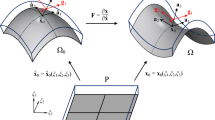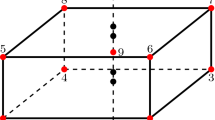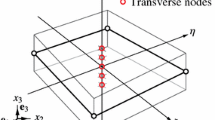Abstract
In this work a previously proposed solid-shell finite element, entirely based on the Enhanced Assumed Strain (EAS) formulation, is extended in order to account for large deformation elastoplastic thin-shell problems. An optimal number of 12 enhanced (internal) variables is employed, leading to a computationally efficient performance when compared to other 3D or solid-shell enhanced elements. This low number of enhanced variables is sufficient to (directly) eliminate either volumetric and transverse shear lockings, the first one arising, for instance, in the fully plastic range, whilst the last appears for small thickness’ values. The enhanced formulation comprises an additive split of the Green-Lagrange material strain tensor, turning the inclusion of nonlinear kinematics a straightforward task. Finally, some shell-type numerical benchmarks are carried out with the present formulation, and good results are obtained, compared to well-established formulations in the literature.
Similar content being viewed by others
Author information
Authors and Affiliations
Corresponding author
Additional information
Funding by Ministério da Ciência e do Ensino Superior (FCT and FSE) (Portugal) under grant PRAXIS XXI/ BD/21662/99; as well as the funding by FEDER, under grant POCTI/EME/47289/2002, are gratefully acknowledged.
Rights and permissions
About this article
Cite this article
Valente, R., Sousa, R. & Jorge, R. An enhanced strain 3D element for large deformation elastoplastic thin-shell applications. Computational Mechanics 34, 38–52 (2004). https://doi.org/10.1007/s00466-004-0551-7
Received:
Accepted:
Published:
Issue Date:
DOI: https://doi.org/10.1007/s00466-004-0551-7




